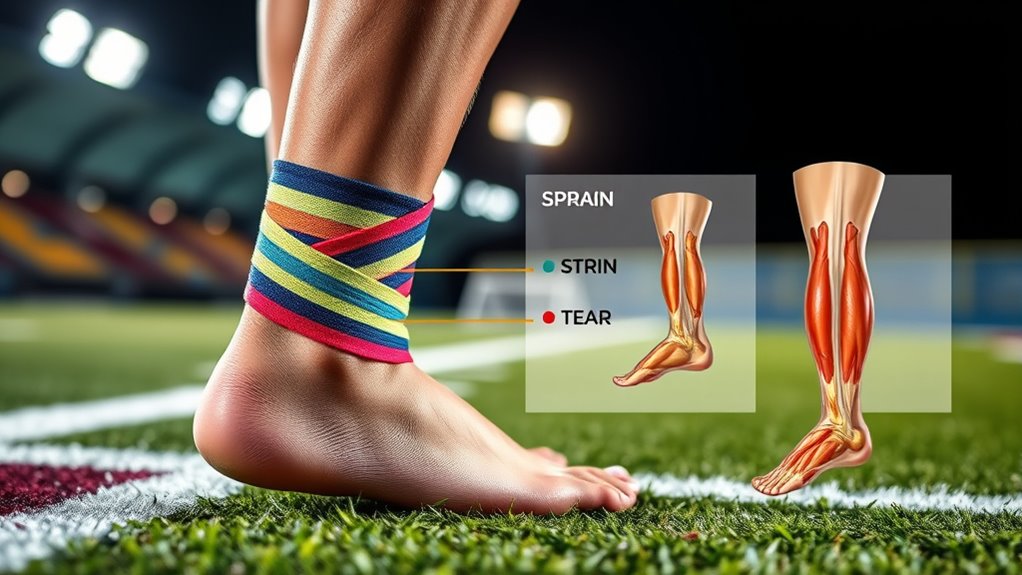Understanding sports injury terms like sprains, strains, and tears helps you recognize problems early. A sprain involves overstretching or tearing ligaments, while a strain affects muscles or tendons. Tears are more severe injuries where tissues are partially or fully ripped. Knowing these basics allows you to seek proper treatment quickly and prevent further damage. Staying informed about these terms means you’re better prepared to manage injuries—keep going to learn more about each type and how to handle them effectively.
Key Takeaways
- Sprains involve overstretched or torn ligaments connecting bones.
- Strains are injuries to muscles or tendons, fibrous cords attaching muscles to bones.
- Tears refer to partial or complete ripping of tissues like ligaments, muscles, or tendons.
- Recognizing injury types guides appropriate treatment and rehabilitation strategies.
- Proper management of sprains, strains, and tears promotes healing and prevents further damage.

Have you ever wondered what those medical terms mean when someone talks about sports injuries? Understanding terms like sprains, strains, and tears can help you better grasp what’s happening when you get hurt on the field or during a workout. These injuries often involve damage to muscles, ligaments, or tendons, and knowing the distinctions can guide you toward appropriate treatment and recovery. For example, a sprain involves overstretching or tearing a ligament, the tissue that connects bones to each other. A strain, on the other hand, affects muscles or tendons—the fibrous cords that attach muscles to bones. Tears are more severe injuries where tissues are partially or completely ripped, often requiring more extensive treatment.
Recognizing these differences is vital because they influence how you approach rehabilitation techniques. Mild sprains or strains might respond well to R.I.C.E.—rest, ice, compression, and elevation—along with gentle stretching and strengthening exercises. More serious tears could need physical therapy, and in some cases, surgical intervention. Understanding the specific injury helps you and your healthcare provider develop a tailored plan that promotes healing and prevents further damage. Proper rehabilitation techniques are essential not only for recovery but also for regaining strength and flexibility, reducing the risk of re-injury.
Prevention strategies play a key role in avoiding these injuries altogether. Warming up before activity, maintaining good flexibility, and building strength in supporting muscles can make a big difference. For instance, focusing on core stability and balance exercises can help stabilize joints and reduce the likelihood of sprains. Wearing appropriate footwear and using proper techniques during sports or workouts also considerably decrease injury risk. Learning and practicing these prevention strategies can keep you on the field longer and help you avoid setbacks caused by injuries like sprains, strains, or tears.
If you do get hurt, knowing what the injury is will help you seek the right treatment promptly. Ignoring pain or pushing through injuries might lead to more severe damage, longer recovery times, or chronic issues. Always listen to your body and consult with healthcare professionals when pain persists or worsens. Remember, the goal isn’t just to heal but to return stronger, better prepared, and less vulnerable to future injuries. By understanding these common sports injury terms and their implications, you can take proactive steps to protect yourself and stay active for the long haul.
Frequently Asked Questions
How Can I Prevent Sports Injuries Like Sprains and Strains?
To prevent sports injuries like sprains and strains, you should focus on proper stretching before activity and cooling down afterward. Wearing protective gear, such as ankle braces or knee pads, adds extra support and reduces risk. Also, make certain you condition your muscles gradually, stay hydrated, and avoid overexertion. Paying attention to your body’s signals and maintaining good technique can keep you safe and help you enjoy sports longer.
When Should I See a Doctor for a Sports Injury?
You should see a doctor immediately if you notice severe pain, swelling, or inability to move the injured area. Conduct a symptom assessment to identify signs like bruising or numbness, which could indicate a serious injury. If you suspect high injury severity, such as a tear or fracture, seek medical attention promptly. Don’t delay if symptoms worsen or don’t improve with rest, as proper treatment is vital for recovery.
What Are the Long-Term Effects of Untreated Ligament Tears?
Imagine you’re stuck in a time warp, and your ligament tear remains untreated. Over time, this can cause chronic instability, making your joint prone to further injuries. Without proper care, you risk developing osteoarthritis, leading to joint pain and stiffness that worsens with age. Ignoring a ligament tear might seem minor now, but it can have lasting effects on your mobility and quality of life.
Are There Specific Warm-Up Routines to Avoid Common Injuries?
To avoid common injuries, you should incorporate dynamic stretching into your warm-up routine, which helps increase blood flow and loosen muscles. Also, stay properly hydrated before and during exercise, as dehydration can lead to muscle cramps and strains. Avoid static stretches during warm-up, and focus on movements that mimic your activity. These steps prepare your body, reduce injury risk, and improve overall performance.
How Does Age Affect Recovery From Sports-Related Injuries?
You might think age doesn’t matter, but aging effects actually slow down your recovery time from sports injuries. As you get older, your body’s healing processes become less efficient, making recovery longer and more challenging. While staying active helps, you should listen to your body, give yourself extra time to heal, and consult health professionals to develop a tailored rehab plan that accounts for these age-related changes.
Conclusion
Just like a hero facing trials in a story, understanding sports injury terms helps you navigate setbacks with confidence. Knowing the difference between a sprain, strain, or tear keeps you one step ahead, ready to act wisely. Remember, every injury tells a tale—your story of resilience begins with knowledge. Stay informed, listen to your body, and trust that every challenge is a chapter toward your comeback. Be prepared, and keep moving forward.









